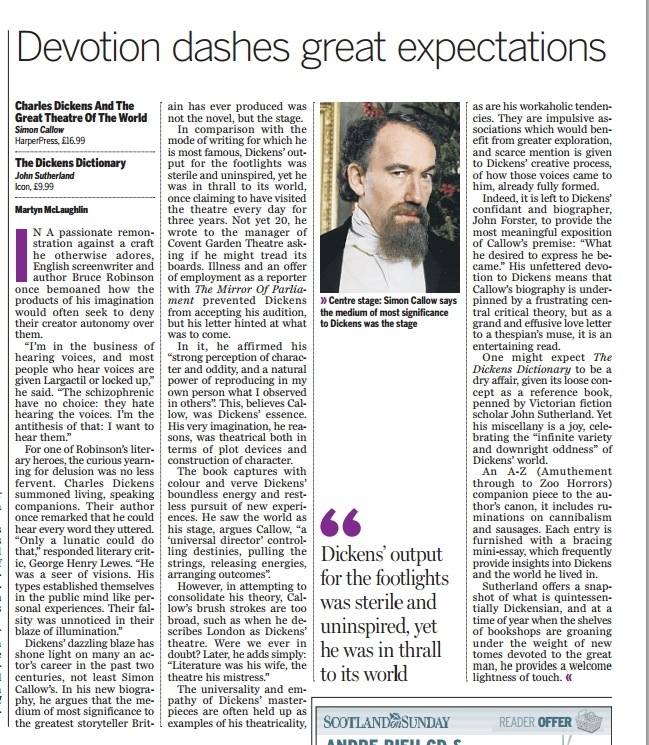Martyn McLaughlin
Charles Dickens and the Great Theatre of the World by Simon Callow
IN a passionate remonstration against a craft he otherwise adores, English screenwriter and author Bruce Robinson once bemoaned how the products of his imagination would often seek to deny their creator autonomy over them.
“I’m in the business of hearing voices, and most people who hear voices are given Largactil or locked up,” he said. “The schizophrenic have no choice: they hate hearing the voices. I’m the antithesis of that: I want to hear them.”
For one of Robinson’s literary heroes, the curious yearning for delusion was no less fervent. Charles Dickens summoned living, speaking companions. Their author once remarked that he could hear every word they uttered. “Only a lunatic could do that,” responded literary critic, George Henry Lewes. “He was a seer of visions. His types established themselves in the public mind like personal experiences. Their falsity was unnoticed in their blaze of illumination.”
Dickens’ dazzling blaze has shone light on many an actor’s career in the past two centuries, not least Simon Callow’s. In his new biography, he argues that the medium of most significance to the greatest storyteller Britain has ever produced was not the novel, but the stage.
In comparison with the mode of writing for which he is most famous, Dickens’ output for the footlights was sterile and uninspired, yet he was in thrall to its world, once claiming to have visited the theatre every day for three years. Not yet 20, he wrote to the manager of Covent Garden Theatre asking if he might tread its boards. Illness and an offer of employment as a reporter with The Mirror Of Parliament prevented Dickens from accepting his audition, but his letter hinted at what was to come.
In it, he affirmed his “strong perception of character and oddity, and a natural power of reproducing in my own person what I observed in others”. This, believes Callow, was Dickens’ essence. His very imagination, he reasons, was theatrical both in terms of plot devices and construction of character.
The book captures with colour and verve Dickens’ boundless energy and restless pursuit of new experiences. He saw the world as his stage, argues Callow, “a ‘universal director’ controlling destinies, pulling the strings, releasing energies, arranging outcomes”.
However, in attempting to consolidate his theory, Callow’s brush strokes are too broad, such as when he describes London as Dickens’ theatre. Were we ever in doubt? Later, he adds simply: “Literature was his wife, the theatre his mistress.”
The universality and empathy of Dickens’ masterpieces are often held up as examples of his theatricality, as are his workaholic tendencies. They are impulsive associations which would benefit from greater exploration, and scarce mention is given to Dickens’ creative process, of how those voices came to him, already fully formed.
Indeed, it is left to Dickens’ confidant and biographer, John Forster, to provide the most meaningful exposition of Callow’s premise: “What he desired to express he became.” His unfettered devotion to Dickens means that Callow’s biography is underpinned by a frustrating central critical theory, but as a grand and effusive love letter to a thespian’s muse, it is an entertaining read.
One might expect The Dickens Dictionary to be a dry affair, given its loose concept as a reference book, penned by Victorian fiction scholar John Sutherland. Yet his miscellany is a joy, celebrating the “infinite variety and downright oddness” of Dickens’ world.
An A-Z (Amuthement through to Zoo Horrors) companion piece to the author’s canon, it includes ruminations on cannibalism and sausages. Each entry is furnished with a bracing mini-essay, which frequently provide insights into Dickens and the world he lived in.
Sutherland offers a snapshot of what is quintessentially Dickensian, and at a time of year when the shelves of bookshops are groaning under the weight of new tomes devoted to the great man, he provides a welcome lightness of touch.

Discussion
No comments yet.